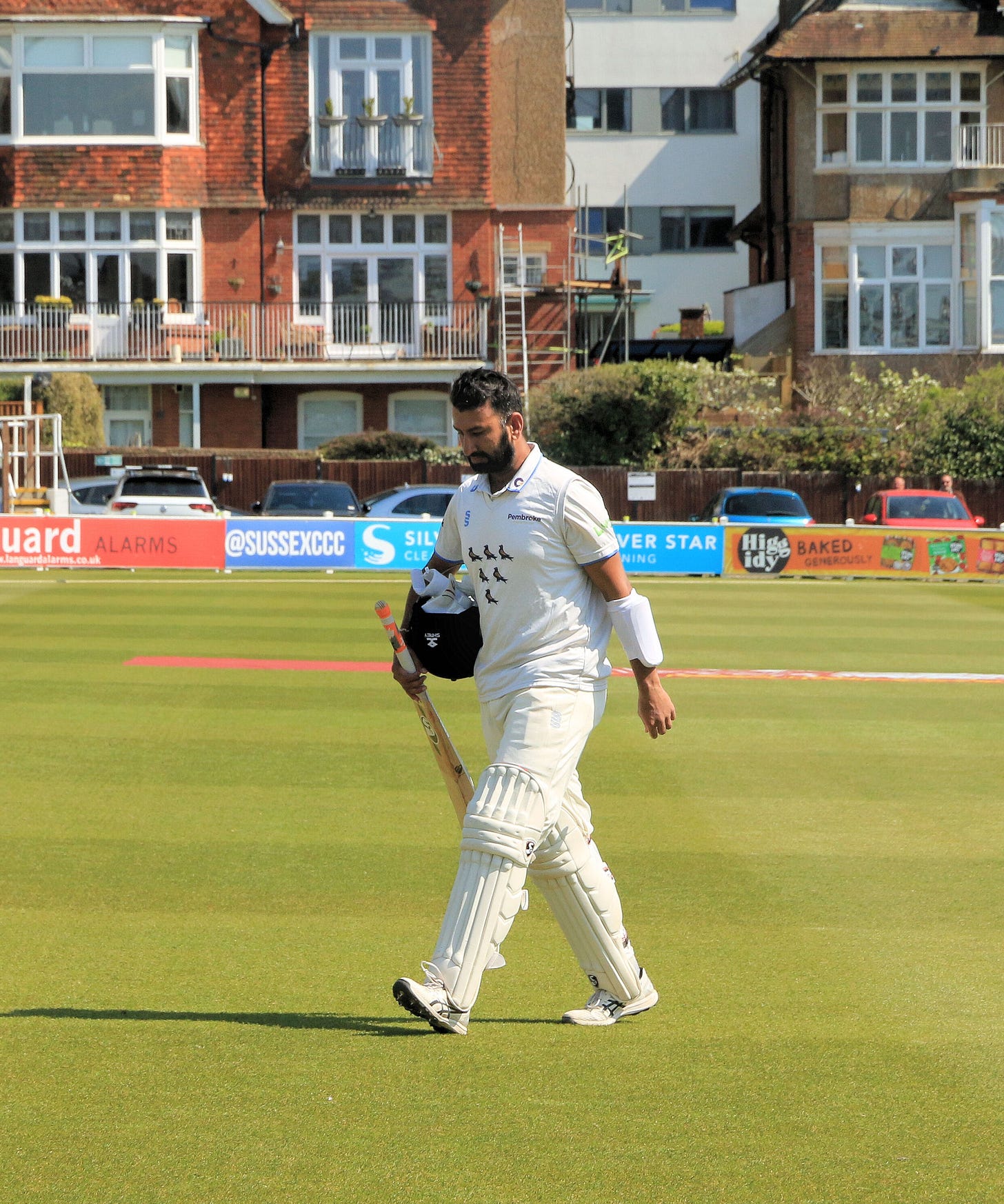Pujara Slips Out the Side Door
GH pays tribute
Cheteshwar Pujara had a mannerism whose description always eluded me. Just before taking strike to each delivery, he would lean back slightly and gaze for a second at the splice on the back of his bat, before settling into that familiar stoop and tap.
It was Pujara’s equivalent of Tendulkar’s preliminary glance to the sun. My friend Malcolm Knox once likened it admirably to an angler subtly flexing his rod, preparatory to casting, and on this I could not improve so I left it alone. But knowing I’ll never see it again live, Pujara having retired with typically little fanfare aged thirty-seven, it subtly swamps other memories.
Pujara was four when his father Arvind, a railways clerk from Rajkot, first put a toy bat in his son’s hands, telling his wife: ‘I think this boy may learn cricket easily.’ He started taking Chintu, as he was called, to a nearby ground, and lobbing a rubber ball at him, 50 to 100 throws at a time. After only a few months, they graduated to a cricket ball, and Chintu was equipped with tiny pads cut from a foam mattress. The custom continued, every morning and evening, as ritually as a visit to a temple or shrine, until Pujara’s basic strokes were as ingrained as sacred utterances or religious incantations. Father enjoined son not to play street cricket - he did not want impurities to enter the boy’s system - and it worked. When finally Chintu commenced competitive cricket aged twelve, he peeled off centuries at will - singles, double, triples. In his second match for Saurasthra, he made 145, and his average had swelled to more than 60 by the time he debuted for his country in Bengaluru.
All the time, this little unconscious nod - not a trigger movement per se, but a quiet act of communion with his most trusted adjunct. For while cliche dictates that some batters wield a bat like an axe, or a broadsword, or a surgical knife, or a switchblade, Pujara seemed to incorporate the bat into his anatomy - it was part of his seemingly impenetrable forward press, which also incorporated shoulder, arm, elbow and haunch. Has any better seemed possessed of a bigger thigh pad? Pujara’s body was ever on the line. You could dash yourself against his defences all day - viz Brisbane 2021 - and he would still be standing at the end of it. The bat in that? Harold Pinter described Hutton’s bat as an extension of his nervous system; Pujara’s bat felt like part of his soul. Contemplating it in all humility, he reverted to that fervent and self-effacing disciple of his life-long craft.
Test match batting proved his metier, Pujara’s upbringing having paved the way. He defended doughtily, of course, though he could also play attractively - that measured square drive when the ball was full (see above) was a signature. He finished with nineteen hundreds, including five against Australia, against whom he averaged almost 50. His average in Indian victories likewise compares favourably to Kohli’s and Dravid’s; he hit the winning runs in his hundredth Test. Kartik has a lively and comprehensive appreciation here.
Yet Pujara may end up, like a renunciate, defined as much by what he didn’t do: he was chosen for only five one-day internationals, while T20’s gaudy enticements fitting him neither technically nor temperamentally. It felt all wrong four years ago when Chennai Super Kings abruptly added him to their list, after earlier abortive stints at three other franchises. In the end, as he had earlier abjured street cricket, he did not play. One imagines him in the nets between times, looking down at the back of his bat before dabbling abortively in ramps and range hits. But it was simply not in his nature to use that bat, as most do in T20, as a licensed assault weapon. He has, one notes, retired from ‘all forms of cricket’. From most forms, the game had already retired him.
Pujara was plagued in later years by the BCCI’s mean-minded parochialism - the rubbish tip pitches they doctored for their spinners. He belonged in some way to a braver era, personified by Virat Kohli, where India challenged all comers in all climes, rather than cynically rigging the game. From a personal point of view, he was a pleasure to write about. He gave you plenty of time, much to admire and a great deal to reflect on, even if it felt hard to do him, and his trusty bat, justice.





It’s rare to read a comment from the hard nosed press that “someone was good to write about,”.
It always seemed though that Pujara was a solid player, totally committed to his team and the cause.
He was not involved in melodrama He came over as decent, and he has given great service to the game. Let us hope that he utilises his abilities for the benefit of others and gains enjoyment from so doing.
Beautiful stuff, Gideon. I loved watching Che play. He felt like a throwback, a classic batter from the generation before. But he was always great to watch.